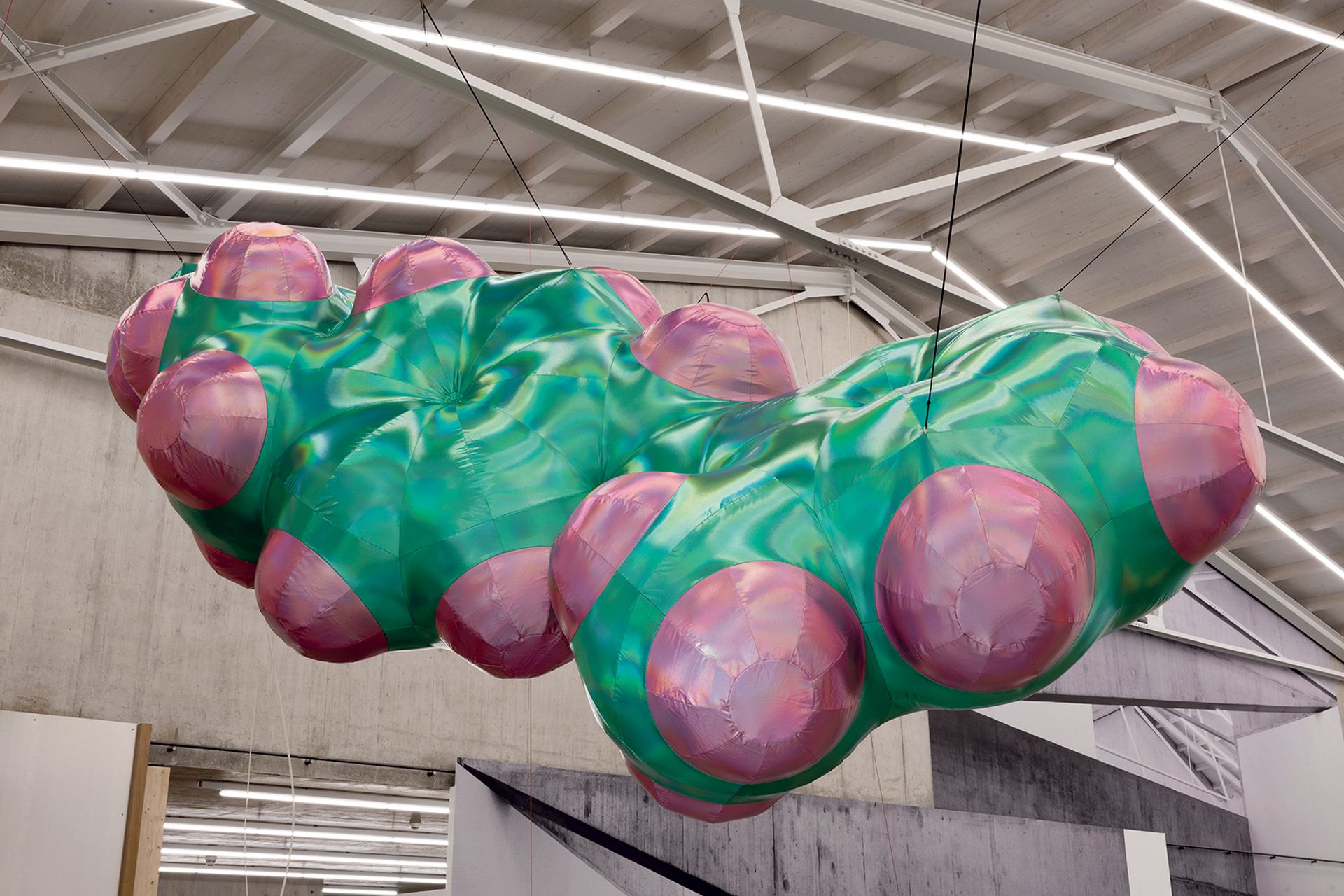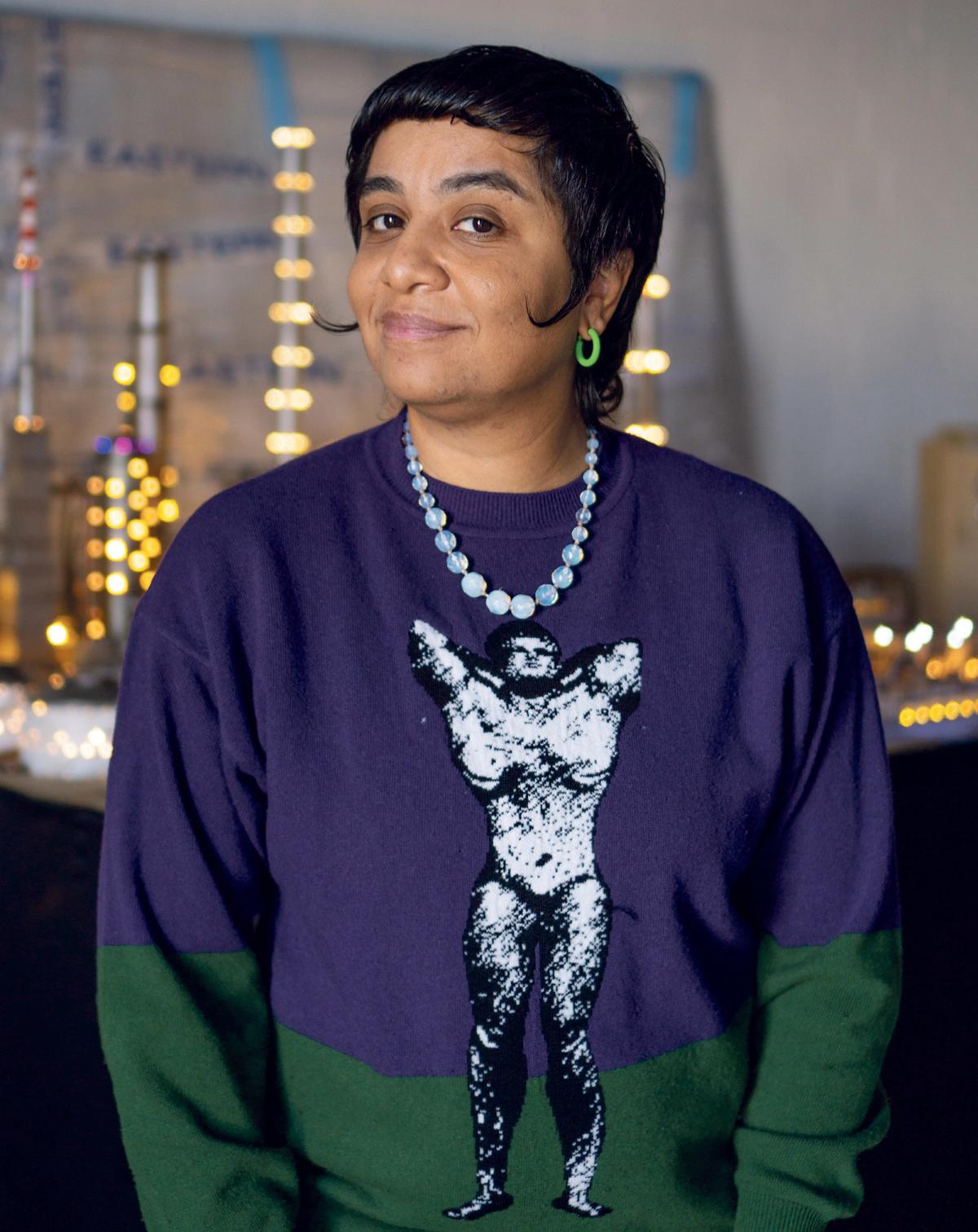There are no simple answers in the work of Monira Al Qadiri. Perhaps the biggest motif in her practice has been oil—a substance inextricably tied to the history of Kuwait, where she was raised. Over the past decade, she has made work that explores the joys, the dangers and the otherworldliness that oil represents. Al Qadiri was born in Senegal, and has lived in several other countries, including Japan, Lebanon and Germany, where she is now based. Science fiction and her own autobiography are key themes in her work. Her shimmering, rainbow-hued renderings of oil drills, for example, reference the pearl trade—once so important to the Persian Gulf—and her grandfather’s career as a singer on a pearling boat.
Al Qadiri is exhibiting a new work from her ongoing series BENZENE FLOAT in the group show Rewilding at Kunsthaus Baselland. An oversized balloon resembling petrochemical compounds, it is an imposing addition to what is the institution’s first exhibition in its new space, located in a former champagne factory.
The Art Newspaper: Could you tell us about how your involvement with the Rewilding show came about?
Monira Al Qadiri: I actually showed a work at Kunsthaus Baselland last year—an existing video piece called Holy Quarter (2020). I’ve been working on these inflatable sculptures for a while, and I thought it might be nice, because of the new building, to have this bombastic artwork celebrating it. I think it’s seven and a half metres long.
It touches on what feels like the biggest thread in your work, which is oil. How has your relationship to this subject shifted over time?
I’ve been working around this topic for around 11 years now. My ideas are really developing in terms of this relationship between humans and nature, and how we approach this ecological, environmental condition. Fossil fuels were maybe a personal entry into this because of my background, but now I’m having more, let’s say, evolved ideas about humans, beasts, bioengineering and different things. I think my new works come from the same place but they are also wildly different.
It feels like it would be easy to frame oil as something menacing or negative. But you’ve always complicated that.
I always thought the question, like you suggest, is a little bit oversimplified. Everybody is dependent on it in a sense, and if you try to distance yourself from it, you are being a hypocrite. Even your clothes are made of it; sometimes your shampoos are made of it. I read an article recently that said every human testicle that this group of scientists had checked contained microplastics [crude oil being a base material for making many plastics]. It’s incredible how it’s even part of our biology.
I am aware of the miraculous nature of the substance that has revolutionised the way we live, but it’s also destroying us. And how do you reconcile these things? I don’t know. I’m just reflecting the times. I’m not an activist. My work is really about thinking about the past, the present and the future and trying to imagine different scenarios. I do this using the visual identity of Kuwait, which used to be this pearl-diving culture, and try to reflect that into oil.

Al Qadiri’s inflatable BENZENE FLOAT takes the form of chemical compounds, but also references cartoons and science fiction from the artist’s childhood © the artist
Pearls hold a deeply personal resonance for you, because of your grandfather.
Yes. He was a singer on a pearl diving boat [whose role was to motivate and encourage the divers]. I feel like I’m the singer, but in the art sense. I’m singing about tragedy and sadness and climate catastrophe, but I’m not really doing anything about it. I’m not diving into the water.
Aliens seem to recur again and again in your work. What keeps drawing you back to that?
I see myself as an alien. I’m Kuwaiti, but I lived in Japan, and then I went to Lebanon, and now I live in Berlin. My cultural identity is very kind of Frankenstein-esque. That’s maybe why I imagine the oil as also being a kind of alien being—I mean, it’s almost science fictional that you take this substance from the earth, and then you turn it into shoes.
I’m also a child of the 80s. I grew up with science fiction and cartoons and the aesthetics of them very much feed into my practice. BENZENE FLOAT, for example, references these cartoon worlds that I grew up with, where giant robots and forms are invading your space.
The translation of culture across space and time is a recurring theme in your work. How much do you think about how your work will be received by different audiences?
People really conceptualise my work very differently from place to place, and I think that’s a great thing. I had a film many years ago called Wa Waila (Oh Torment) (2008), in which I’m acting this role of a singer. I’m trying to kind of mimic my grandfather a little bit. I showed it in these film festivals, and the reaction was so bizarrely different. People who saw it in Dubai were laughing, they thought it was a comedy. And then people in Japan, they cried, they thought it was completely tragic. And then I showed it to Germany, and they were like, “Oh my god, this is very artistic.” After that point, I gave up [thinking about] how people are reading my work.
Previously, you’ve referenced your work in the context of a trope in Arabic poetry, “crying at the ruins” or “standing at the ruins”. Could you tell me a bit more about that?
I wrote a thesis called The Aesthetics of Sadness in the Middle East, and it was very much about this appreciation of sadness as a noble human emotion. In the modern world, I think because of capitalism and the obsession with productivity and things like that, melancholia has been looked down upon, almost like it’s a disease or sickness. But at some point in time, I think everybody shared this idea that sadness can have the ability to inform your life. Arabic poetry and song and all of this culture is very much based on appreciating tragedy, and in Europe, let’s say in ancient Greece, there was the same kind of idea that tragedy can be really inspirational.
My works all have this very seductive, very shiny, flashy kind of outer shell, but on the inside they really hide this kind of tragic characterMonira Al Qadiri
My works all have this very seductive, very shiny, flashy kind of outer shell, but on the inside they really hide this kind of tragic character. It’s about the erasure of history and the concealment of what is going on in the world in terms of fossil fuels and the inevitability of the end of the fossil-fuel era. These things are not easy subjects, but I try to play both sides.
You’ve grown up surrounded by art: your mother is an artist, and your sister is a musician. How much have they influenced you? Does this come with any challenges?
With my mum, for us it just became this way of life. If you open your eyes and there’s an art studio as a child, this is your playroom, you know? And I’m glad that she didn’t kick us out. She just let us do our thing in there. My mother is kind of my hero, because she’s been a practicing female artist in Kuwait since the 60s, which is a very rare thing. So I’m trying to hold her mantle, and she’s very excited about everything I do.
My sister has been my collaborator since we were around two years old. We are just on the same wavelength all of the time; it’s almost like a telepathic relationship. We grew up both making art and music, and there is still some overlapping that happens between us. She’s my harshest critic but also my inspiration.
• Rewilding, Kunsthaus Baselland, Münchenstein, until 18 August


